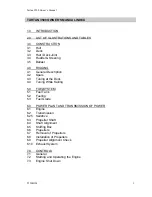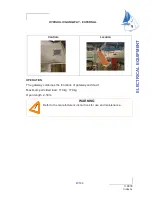
65
DON’Ts
•
Do not drill or break through the powder-coating film unless absolutely necessary. As
much as possible, fastener holes should be drilled or punched before powder-coating.
•
Do not use organic solvents containing esters, ketones, alcohols, aromatic compounds,
glycolic ether, or halogenated hydrocarbons.
•
Do not use excessively alkaline or acidic cleaners.
•
Do not use detergents at more than 77° F.
•
Do not allow contact with teak cleaners.
•
Do not allow wet cushions or covers to be in constant contact with the powder-coat.
•
Do not shrink-wrap or tightly bind painted or powder-coated surfaces with plastic
wrappings.
•
Do not use abrasives or abrasive cleaners.
Accelerated life tests have shown that powder-coat materials are particularly susceptible to the following
products and they should not be used on the powder-coated surfaces:
Sodium
Hydroxide
Metyl-Ethyl-Ketone (MEK)
Xylene
Ammonia
Hydrochloric acid
Sulfuric acid
Tempered glass – Most of the windshield sections are made of tempered glass (i.e., the windshield vent
assembly, the two front windshield panels and the two aft panels. Each of these panels will have a very
small, discreet label that states that they are made of tempered glass (i.e., FLT Glass Tempered). The
two curved panels are made of acrylic, not tempered glass and should not be treated in the same
manner.
To clean the tempered glass panels use commercially available glass cleaners or a mixture of fresh water
and vinegar. Do not use abrasives, harsh chemicals or metal scrapers. Regular cleaning will help assure
clarity of the glass for safe boating.
Acrylic – The two curved sections are made of acrylic. They DO NOT have a tempered label affixed to
them. The windshield manufacturer recommends that you hose down the entire windshield assembly on
a regular basis. If any grit or grime is present, avoid grinding it into the surface as you carefully dislodge
it. Allow the acrylic panels to air dry.
If further leaning is required, use a very soft cotton cloth and clean with a mixture of warm water and mild
dish washing soap such as Ivory or Dawn. Make certain that there is no cross contamination on the
cotton cloth. Then, allow the acrylic panels to air dry.
Grease and adhesives may be removed with kerosene, hexane or white gas (not gas you
burn in your boat, car, or lawnmower). Never use solvents such as acetone, silicone
spray, benzene, carbon tetrachloride, dry cleaning fluid, lacquer or paint thinner, or any
chlorinated solvent on acrylic since they may dissolve the material.
Curtain Package and Windscreen
Canvas
One of the best ways to keep Sunbrella brand fabrics looking good and to delay the need for deep or
vigorous cleanings is to hose fabrics off on a monthly basis with clear water. This practice will help
prevent dirt from becoming deeply imbedded in the fabric and eliminate the need for more frequent
vigorous cleanings. In most environments, a thorough cleaning will be needed every two to three years.
When it's time for a thorough cleaning, Sunbrella fabrics can be cleaned while still installed on your boat.
It is important to observe the following:
Содержание 35 Express 2006
Страница 2: ...ii ...
Страница 12: ...5 ...
Страница 82: ......
Страница 83: ......
Страница 84: ......
Страница 85: ......
Страница 86: ......
Страница 87: ......
Страница 88: ......
Страница 89: ......
Страница 90: ......
Страница 91: ......
Страница 92: ......
Страница 93: ......
Страница 94: ......
Страница 95: ......















































